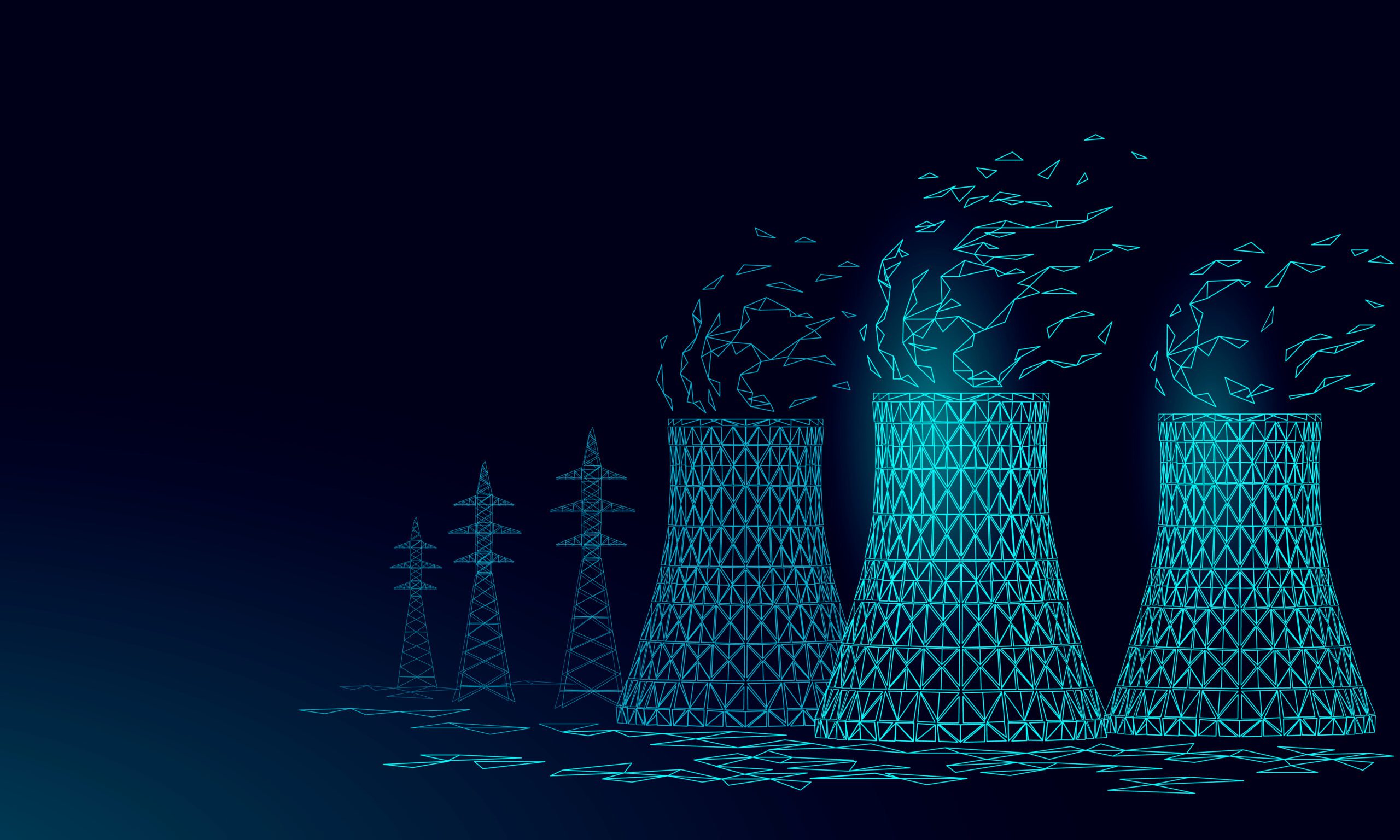Governments around the world are making ambitious net-zero pledges in an effort to curb global warming, prompting a shift toward cleaner, low carbon energy solutions. Driven by government mandates and pressure from investors, companies in industries like energy, mining and tech are setting goals to reduce carbon emissions. For example, Shell has pledged to become a net-zero energy business by 2050, mining giant Rio Tinto has set a target to reduce Scope 1 and 2 emissions by 50% by 2030 and aims to achieve net-zero emissions by 2050, and Microsoft is committed to being carbon dioxide negative by 2030.
One of the strategies companies are using to work towards net-zero goals is reducing carbon emissions across their operations. Introducing clean energy sources and increasing energy efficiency, as well as implementing carbon capture and storage projects, can help achieve this.
For companies with high energy needs and remote operations, SMRs could be a game-changing solution in the race to net-zero. Small modular nuclear reactors, or SMRs, are nuclear reactors designed to be built in a factory and installed onsite. They are an affordable alternative to large nuclear power plants and ideal for industrial operations with high energy needs demands or remote locations without existing energy infrastructure.
In this blog post, we’ll discuss:
• How SMRs can help energy and tech companies meet net-zero goals
• Regulatory and commercialization challenges
• The importance of standards and innovation in emerging technologies
Interested in digital standards and innovation solutions?
SMRs compared to traditional reactors
Nuclear power is already an important part of the energy mix, providing safe, clean energy in more than 30 countries. Small nuclear reactors were first designed in the 1950s to provide nuclear propulsion for military submarines and ships. In recent years, interest in SMRs for industrial applications has exploded. They have the potential to provide clean, efficient power in remote areas with little infrastructure and limited connectivity to the electrical grid.
Compared to traditional nuclear power plants, SMRs offer several advantages:
• Smaller footprint: about one-third the size of a traditional reactor
• Shorter construction time: 2-3 years compared to 6-8 years
• Lower upfront costs: due to shorter construction time and smaller size
• Scalability: additional units can be added to increase power output
SMRs also boast a long service life and low maintenance needs, contributing to their overall sustainability and cost-effectiveness.
SMRs and the energy transition: a new low carbon energy solution
SMRs have the potential to play a key role in meeting net-zero goals in the energy, mining and tech industries:
Oil & gas and mining
The production, transport and processing of fossil fuels is incredibly emissions intensive, accounting for nearly 15% of global energy-related greenhouse gas emissions, according to the International Energy Agency. These operations frequently occur in remote areas with no connectivity to the electric grid. Drilling for oil or operating a mine requires huge amounts of energy, which is typically provided by diesel-powered generators. Diesel is costly and a notorious carbon emitter and can be logistically difficult to transport to remote locations.
SMRs could be the alternative power source the mining and energy industry needs. They can provide onsite, reliable, emission-free power and do not rely on existing infrastructure. The small footprint and ability to be scaled up make them ideal for mining operations. Floating nuclear power plants can supply the energy that offshore drilling operations need, without the greenhouse gas emissions. Lowering carbon emissions in the mining and energy industry is crucial for mitigating climate change and promoting environmental responsibility.
Tech
In 2022, data centers accounted for 1-1.5% of global electricity consumption and 1% of energy-related greenhouse gas emissions. While clean and renewable energy sources are being incorporated into the global energy mix, fossil fuels still account for nearly 60% of electricity generation in the U.S. and 35% in the EU. With the growing use of AI and cloud computing, data center power consumption is projected to increase more than 160% by 2030.
SMRs are uniquely positioned to reduce emissions and help tech companies meet their net-zero goals. Data centers require constant, uninterrupted power supply, and nuclear power is both reliable and emissions-free. The small, modular design allows them to be assembled near data centers and scaled up if energy needs increase. By working closely with tech companies, SMR providers can ensure that their energy solutions meet the specific needs of their customers. The value of SMRs lies in their ability to provide reliable, clean energy for data centers, ensuring operational continuity and supporting sustainability goals.
In January 2025, TerraPower, a nuclear innovation company and Sabey Data Centers (SDC), a leading data center developer, owner, and operator, entered into a Memorandum of Understanding (MOU) to explore the development of TerraPower’s advanced Natrium reactor technology to meet the growing energy demands of data centers. The collaboration focuses on integrating Natrium plants into SDC’s current and future data center operations, particularly in the Rocky Mountain region and Texas.
The Natrium reactor is an innovative advanced nuclear reactor which uses molten salt storage and sodium cooling which therefore makes it highly flexible, and its modular design allows for more accessible deployment, especially in regions with varying energy demands. The design aims to provide clean, uninterrupted energy to support the boom of data centers, which are projected to experience significant increases in power consumption due to the rising use of artificial intelligence and cloud computing.
This partnership exemplifies how advanced nuclear technologies like SMRs can address the substantial and increasing energy requirements of the tech industry while supporting the transition to clean energy.
Challenges with SMR commercialization
SMRs offer a compelling net-zero solution, with the potential to provide affordable, safe, clean and reliable energy, but as a developing technology, commercialization, regulation, and large-scale deployment face complexities influenced by various markets. Globally, there are more than 80 SMR designs and concepts under development. However, only a few SMRs are operational today, including two on Russia’s Akademik Lomonosov floating nuclear plant and China’s HTR-PM, which entered full commercial operation in December 2023. Japan also operates a research SMR, the HTTR (High-Temperature Engineering Test Reactor), but it is not used for commercial power generation. As such, while SMRs hold great promise, the technology has yet to be proven at commercial scale and deployed widely. Scaling is crucial for manufacturing growth in the renewable energy sector, but it involves navigating the complexities of low-carbon solutions.
The industry faces several challenges in commercializing SMRs:
Regulatory and licensing
The regulatory landscape for SMRs presents a significant hurdle to widespread adoption, as the existing international nuclear conventions were established before current SMR technologies were developed. These regulations may need to be adapted to account for the unique designs, modular capacities and safety features of SMRs. While organizations like ASME, IAEA and CSA are actively developing SMR-specific standards, effective standardization will only be achieved through international and industry-wide collaboration. Leveraging expertise to navigate these regulatory challenges is crucial for the successful deployment of SMRs.
The licensing process itself remains complex and time-consuming, involving multiple stakeholders, regulatory reviews and extensive coordination meetings. Since SMRs often rely on government funding and policy support, the process is unfortunately subject to delays and setbacks due to changes in political administration.
Innovative solutions are essential in addressing these regulatory and licensing challenges, as they can streamline processes and enhance compliance with evolving standards.
A timely example is the U.S. Department of Energy’s (DOE) $900 million funding realignment in March 2025. This solicitation was reissued to better align with the current administration’s energy priorities, emphasizing energy security, industrial growth and American leadership in AI and advanced energy. The funding aims to de-risk the deployment of Generation III+ SMRs. The evaluation criteria was restructured to focus on project achievability, financial viability, licensing readiness, and team capabilities, which demonstrates how changes in political leadership can significantly shape both the licensing and funding landscape for SMRs.
Large-scale deployment
For SMRs to be produced affordably and at a low cost, their designs must be standardized to streamline manufacturing. A robust manufacturing infrastructure and skilled workforce needs to be in place to support production. Additionally, securing a reliable supply chain for both construction materials and nuclear fuel is essential. Leveraging deep technical, commercial, and regulatory expertise is crucial in supporting the production and deployment of SMRs. Once SMRs have been manufactured and assembled, a workforce must be developed to operate and maintain them, ensuring their long-term viability as a clean energy solution.
SMRs: a climate change solution for industrial facilities
SMRs have the potential to be a powerful tool in the race to net-zero, providing reliable, clean energy for industrial operations while benefiting the environment by reducing greenhouse gas emissions. However, realizing this potential requires overcoming significant hurdles. To make SMRs commercially viable, innovation in engineering, strong support from the standards community and a streamlined licensing process will be essential.
A promising example of this is Ontario Power Generation’s (OPG) SMR project at the Darlington site, which recently became the first in Canada to receive a license to construct and the first grid-scale SMR deployment among G7 countries. With plans for multiple units and support from government and industry, it illustrates how regulatory collaboration and technological innovation can turn SMR potential into real world progress.
In addition to environmental benefits, SMRs offer significant economic advantages by providing reliable, clean energy for industrial operations, which can translate into economic value for businesses.
With the right policies, technology and industry collaboration, SMRs could play a critical role in helping energy and tech companies meet their ambitious net-zero goals.

